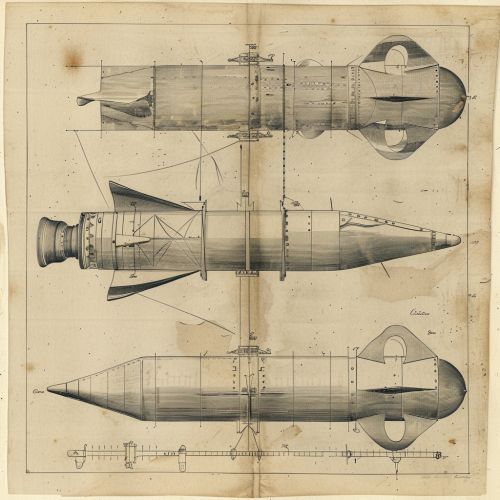History of rocketry
Early Developments in Rocketry
The history of rocketry dates back to ancient times, with early instances of rocket technology appearing in China during the Song Dynasty (960–1279 AD). The Chinese developed gunpowder and utilized it in various forms, including fireworks and rudimentary military rockets. These early rockets were essentially gunpowder-filled tubes attached to arrows, which were launched using bows. The propulsion was achieved through the rapid expulsion of gases produced by the burning gunpowder.
The technology spread to the Middle East and Europe through the Mongol invasions and the Silk Road. By the 13th century, the Mongols had adopted and adapted Chinese rocket technology for use in their military campaigns. The knowledge of rocketry continued to evolve in the Islamic world, with significant contributions from scholars such as Hassan al-Rammah, who documented various types of rockets and their uses in his 13th-century manuscript "The Book of Military Horsemanship and Ingenious War Devices."
European Advancements
In Europe, the use of rockets in warfare became more prevalent during the late Middle Ages and the Renaissance. Notable figures such as Konrad Kyeser and Joanes de Fontana described rocket technology in their works. However, it was not until the 17th century that significant theoretical advancements were made. Isaac Newton's formulation of the three laws of motion provided a scientific basis for understanding rocket propulsion.


The Birth of Modern Rocketry
The modern era of rocketry began in the early 20th century with the pioneering work of several key figures. Konstantin Tsiolkovsky, a Russian scientist, is often regarded as the father of astronautics. In 1903, he published "Exploration of Outer Space by Means of Rocket Devices," which laid the theoretical groundwork for space travel. Tsiolkovsky's rocket equation described the relationship between the velocity of a rocket and the velocity of the exhaust gases, a fundamental principle in rocketry.
In the United States, Robert H. Goddard made significant strides in practical rocketry. In 1926, he successfully launched the world's first liquid-fueled rocket, which reached an altitude of 41 feet. Goddard's work demonstrated the feasibility of liquid propulsion and introduced innovations such as gyroscopic stabilization and steerable thrust.
Meanwhile, in Germany, Hermann Oberth published "The Rocket into Planetary Space" in 1923, which further advanced the theoretical and practical aspects of rocketry. Oberth's work inspired a generation of rocket enthusiasts, including Wernher von Braun, who would later play a crucial role in the development of rocket technology during and after World War II.
World War II and the V-2 Rocket
World War II marked a significant turning point in the history of rocketry, with the development of the V-2 rocket by Nazi Germany. The V-2, designed by Wernher von Braun and his team at the Peenemünde Army Research Center, was the world's first long-range guided ballistic missile. It utilized a liquid-fueled engine and was capable of reaching altitudes of up to 206 kilometers and speeds of 5,760 kilometers per hour.
The V-2 rocket represented a major technological leap and demonstrated the potential of rockets as weapons of war. However, it also highlighted the destructive power of such technology, as the V-2 was used to target civilian populations in London and other cities.
Post-War Developments and the Space Race
After World War II, the United States and the Soviet Union captured German rocket technology and personnel, leading to significant advancements in their respective rocketry programs. Wernher von Braun and many of his colleagues were brought to the United States under Operation Paperclip, where they contributed to the development of the Redstone and Jupiter rockets.
In the Soviet Union, Sergei Korolev emerged as the chief designer of the Soviet space program. Under his leadership, the Soviets developed the R-7 Semyorka, the world's first intercontinental ballistic missile (ICBM) and the launch vehicle for Sputnik 1, the first artificial satellite, which was launched in 1957. This event marked the beginning of the Space Race between the United States and the Soviet Union.
The United States responded with the creation of the National Aeronautics and Space Administration (NASA) in 1958. The subsequent decade saw rapid advancements in rocketry, culminating in the Apollo program and the successful landing of humans on the Moon in 1969. The Saturn V rocket, designed under the direction of Wernher von Braun, remains one of the most powerful rockets ever built.
Modern Rocketry and Space Exploration
In the latter half of the 20th century and into the 21st century, rocketry continued to evolve with the development of new technologies and the expansion of space exploration efforts. The Space Shuttle program, which operated from 1981 to 2011, introduced reusable spacecraft and significantly reduced the cost of access to space.
In recent years, private companies such as SpaceX and Blue Origin have emerged as major players in the field of rocketry. SpaceX's Falcon 9 and Falcon Heavy rockets have demonstrated the potential for reusable launch vehicles, while Blue Origin's New Shepard and New Glenn rockets aim to further reduce the cost of space travel and enable human colonization of other planets.
Future Prospects
The future of rocketry holds exciting possibilities, with ongoing research and development aimed at improving propulsion systems, increasing payload capacities, and enabling long-duration space missions. Concepts such as nuclear thermal propulsion, ion thrusters, and solar sails are being explored to enhance the efficiency and capabilities of rockets.
Additionally, international collaborations and the involvement of private industry are expected to play a significant role in the future of space exploration. The Artemis program, led by NASA, aims to return humans to the Moon and establish a sustainable presence by the late 2020s. Meanwhile, missions to Mars and beyond are being planned, with the goal of expanding humanity's reach into the solar system.
